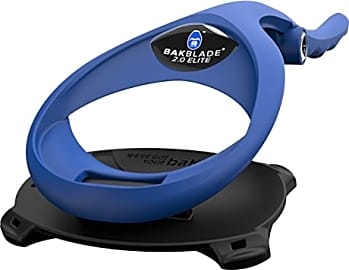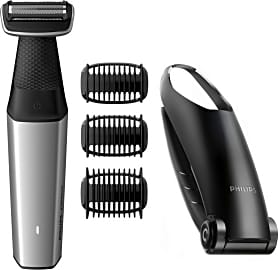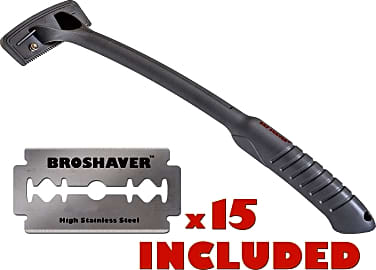The 6 Best Back Hair Shavers

This wiki has been updated 32 times since it was first published in February of 2017. Gentlemen, there is now no excuse for being mistaken for Bigfoot when out hiking without a shirt on. One of these handy back hair shavers will let you reach anywhere on your body without asking awkwardly for assistance or missing entire areas. Whether you manscape on a regular basis or just when it's time to hit the beach, you'll be able to do so in a comfortable and safe manner. When users buy our independently chosen editorial recommendations, we may earn commissions to help fund the Wiki.
Editor's Notes
October 08, 2019:
While everybody knows that electric shavers never render the baby soft skin you can get with manual blades, the Mangroomer Pro still takes the top spot for offering pivoting heads, recognizing that the back is not a flat surface. You'll spend less time trying to navigate awkward angles and it does offer a reasonably close shave, removing all visible hair.
The Bakblade 2.0 Elite also comes highly recommended for solving the problem of how to apply shaving cream in those hard to reach places. The neoprene sleeve is a great addition to this updated model. Their patented blades are not just an effort to get you to spend more money, they allow you the choice to shave dry without razor burn or irritation.
We added the Ultra Flexx DIY, because even though some users may struggle to get their razor tight enough not to wobble, it allows you to choose your angle, and is a great choice for pregnant women or anybody recovering from surgery who can't bend over.
Nobody Loves Back Hair, But Why Use A Shaver?
Many men with back hair simply choose to do nothing about it, and that’s fine, especially if you’re in a stable, committed relationship with someone who’s accepted it.
There’s a good chance that if you have any hair on your back, it’s brought you some shame at some point in your life. We don’t live in a culture that’s particularly fond of body hair, at least not in what we deem to be the wrong places. The back has a special place among those regions; even as the popularity of chest hair and facial hair waxes and wanes with the times, back hair is generally regarded as unattractive.
Many men with back hair simply choose to do nothing about it, and that’s fine, especially if you’re in a stable, committed relationship with someone who’s accepted it. If you’re single, however, the odds that your backside rug are going to do you any favors in the romance department are slim. That’s why so many men seek out ways to reduce or remove the presence of the hair on their backs.
Exactly how you go about taking care of your back hair is an important question. Some men will grab the razor they use to shave their faces and try feebly to reach all the hairy points on their back and shoulders, but more often than not this results in bald spots and an increased potential for razor burn. Others may choose to employ a simple grooming tool like a pair of clippers they’d otherwise use to trim their beards, but these, like the razors, have a reach problem.
Then there’s waxing, and if you’ve ever had to take a band-aid off a hairy area of your body, you can expect the waxing process to feel like that, but on steroids. What’s more, waxing is an expensive endeavor that requires the time commitment of a whole session. There are less painful methods than waxing, like electrolysis, for example, but these are also much more expensive.
Rather than relying on tools that don’t get the job done, or on professionals who overcharge to bring tears to your eyes, you can invest in one of the back shavers on our list. These devices work like razors or clippers depending on the model, but they’re ergonomically designed to be comfortably applied to your back. They also have much larger heads than devices intended for your face, so they can cover more surface area in less time, both reducing razor burn and getting you out of the shower sooner than later.
What To Look For In A Back Hair Shaver
When choosing a shaver for your back, there are a few variables you can examine that will make the selection process go much more smoothly, and smooth is exactly what we’re after. There are certainly different types of shavers out there, but don’t let that discourage you; the perfect option for you is waiting right here.
Some units are merely curved rods with shaving heads on their ends.
For starters, you need to decide whether you want to use a blade or a clipper to get at the hair on your back. Blades have the advantage of giving you a closer shave, so you’ll have to reuse the device less often, potentially prolonging its life and definitely saving you some time. The downside is that they’re more prone to causing razor burn and they can still cut you despite the implementation of modern safety features.
Clipper-style shavers, by contrast, work a lot like hair clippers, reducing the appearance of back hair more than removing it completely. You can work a lot faster with these since you don’t have to worry about cutting yourself, but they won’t get the job done if you’re getting your picture taken professionally or you have a potential romantic partner rubbing their hands across your back.
The other thing you’ll want to look at is portability. By necessity, these devices have to have some kind of curve that will allow you to easily reach your back with them. Some units are merely curved rods with shaving heads on their ends. These are often less expensive, but they’re also significantly less portable. If you want a shaver you can take with you on the road, you’re going to want to look for something that breaks down to fit in your suitcase.
A Brief History Of Manscaping
Like many technological and ritualistic innovations in the history of mankind, we can look to the Egyptians for the roots of modern men’s hair maintenance. In ancient Egypt, excessive body hair was, as it is today, considered unattractive. Most male citizens, from the servants on up to the pharaohs, found time each day to do a little plucking.
Like many technological and ritualistic innovations in the history of mankind, we can look to the Egyptians for the roots of modern men’s hair maintenance.
Later moments in our history concentrated on the management of beards and mustaches as signs of virility and power, and the mustache would see its peak in the 19th century, at a height of popularity that all the hipsters in Brooklyn couldn’t rival.
The term manscaping was first coined on television’s Queer Eye For The Straight Guy, but was likely in use within the LGBT community before that show made it a nationally recognized term. The past 20 years have been marked by a rapid increase in men’s body care products, as well. Manufacturers found a willing and hungry market in men for the types of commodities that had previously been the exclusive domain of women. Of course, women probably don’t need back shavers as often as men do.
Where exactly the preference for a man with less hair comes from is hard to pinpoint. It’s possible that, evolutionarily, we’ve come to unconsciously regard the loss of hair as a sign of higher evolution, but that wouldn’t explain why baldness is looked upon so unfavorably. The more likely explanation is that hairlessness is closely associated with youth, and no one, in any culture throughout time, has longed to get close to their own aging and mortality.











